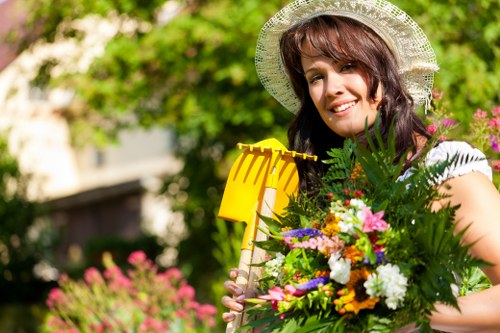Landscape Gardening in Regents Park: Transforming Spaces with Natural Beauty

Regents Park is renowned for its stunning landscapes and meticulously maintained gardens. Landscape gardening in this iconic location plays a crucial role in preserving its beauty and ensuring that both locals and visitors can enjoy the serene environment. Whether you're a gardening enthusiast or a casual visitor, understanding the principles and practices of landscape gardening in Regents Park can enhance your appreciation of this green oasis.
Effective landscape gardening involves a combination of art and science. It requires a deep understanding of plant species, soil conditions, climate, and design principles. In Regents Park, gardeners strive to create harmonious environments that not only look appealing but also support biodiversity and sustainability.
One of the key aspects of landscape gardening in Regents Park is the careful selection of plants. The diverse range of flora ensures that the park remains vibrant throughout the year, with different plants blooming in various seasons. This continuous cycle of growth and renewal is essential for maintaining the park's dynamic beauty.

Another important factor is water management. Regents Park features numerous water bodies, including ponds and streams, which provide habitats for various species. Effective irrigation systems and water conservation techniques are implemented to ensure that the plants receive adequate moisture without wasting water. This balance is vital for the health of the gardens and the overall ecosystem.
The layout and design of the gardens in Regents Park are also meticulously planned. Pathways, seating areas, and decorative elements are strategically placed to enhance the visitor experience. The use of different textures, colors, and forms creates visual interest and guides visitors through the park's diverse landscapes.
Maintenance is another critical aspect of landscape gardening. Regular pruning, weeding, and fertilizing are necessary to keep the gardens in optimal condition. Gardeners in Regents Park employ both traditional and modern techniques to ensure that the plants thrive and the gardens remain immaculate.

The History of Landscape Gardening in Regents Park
Regents Park has a rich history that is deeply intertwined with landscape gardening. Established in the early 19th century, the park was designed to provide a natural escape for the residents of London. The original designers emphasized creating a park that combined natural elements with structured gardens, a philosophy that continues to influence landscape gardening practices today.
Over the years, various landscape architects and gardeners have contributed to the park's development. Each addition has been carefully considered to maintain the park's legacy while introducing innovative gardening techniques. This blend of tradition and innovation is a hallmark of landscape gardening in Regents Park.
The preservation of historical gardens alongside modern installations showcases the park's commitment to honoring the past while embracing the future. Visitors can enjoy a diverse range of garden styles, from classical English gardens to contemporary botanical installations.

Plant Selection and Biodiversity
Plant selection is a fundamental component of landscape gardening. In Regents Park, gardeners choose a variety of plant species that thrive in the local climate and soil conditions. This careful selection ensures that the gardens are resilient and can withstand seasonal changes.
Biodiversity is also a priority. By incorporating a wide range of plants, including native species, gardeners support local wildlife and promote ecological balance. This diversity attracts pollinators, birds, and other beneficial creatures, enhancing the park's natural ecosystem.
Key plant types include:
- Perennials and annuals for continuous blooming.
- Deciduous and evergreen trees for structural diversity.
- Shrubs and groundcovers to provide layers and textures.
- Bulbs and tubers for seasonal color.

Design Principles in Landscape Gardening
Design principles play a crucial role in shaping the aesthetics and functionality of the gardens. In Regents Park, designers adhere to principles such as balance, harmony, contrast, and scale to create visually appealing landscapes.
Balance ensures that no single element overwhelms the others, creating a sense of equilibrium. Harmony involves the cohesive integration of various elements, while contrast adds visual interest through differences in color, texture, or form.
Creating Focal Points
Focal points are essential for guiding the visitor's eye and providing points of interest. These can include sculptures, water features, or particularly striking plant arrangements. In Regents Park, strategically placed focal points enhance the overall design and create memorable experiences for visitors.
Pathway Design
The layout of pathways influences how visitors navigate the park. Curved paths can create a sense of exploration, while straight paths offer clear directions. The materials used for pathways, such as gravel, stone, or pavement, also contribute to the park's aesthetic.

Seasonal Care and Maintenance
Each season presents unique challenges and opportunities for landscape gardening. In Regents Park, maintenance routines are adjusted to accommodate seasonal changes, ensuring that the gardens remain healthy and vibrant year-round.
During spring, gardeners focus on planting new blooms and preparing the soil for growth. Summer requires diligent watering and pest management, while autumn involves leaf clearance and preparing plants for winter. In winter, protective measures are taken to safeguard sensitive plants from frost and cold temperatures.
Regular maintenance tasks include:
- Pruning and trimming to maintain plant health and shape.
- Weeding to prevent competition for nutrients.
- Mulching to retain soil moisture and regulate temperature.
- Fertilizing to provide essential nutrients.

Sustainable Practices in Landscape Gardening
Environmental sustainability is a key consideration in modern landscape gardening. In Regents Park, sustainable practices are implemented to minimize the ecological footprint and promote long-term ecological health.
Some sustainable practices include:
- Using native plants that require less water and are adapted to local conditions.
- Implementing rainwater harvesting systems for irrigation.
- Employing organic fertilizers and pest control methods.
- Promoting biodiversity through the inclusion of various plant species.
These practices not only contribute to the health of the gardens but also support the broader environment by reducing resource consumption and enhancing habitat diversity.
Embracing sustainability in landscape gardening ensures that Regents Park remains a beautiful and ecologically responsible space for future generations.

Community Involvement and Education
Community involvement is vital for the continued success of landscape gardening in Regents Park. Engaging local residents and organizations fosters a sense of ownership and responsibility toward the park.
Educational programs and workshops are often conducted to teach gardening techniques, plant care, and sustainable practices. These initiatives empower individuals to contribute to the maintenance and improvement of the gardens, promoting a collective effort in preserving the park's beauty.
Volunteering opportunities allow community members to participate in various projects, from planting new flowers to maintaining walking paths. This collaboration strengthens the bond between the park and its visitors, ensuring that Regents Park remains a cherished green space.
By fostering a culture of community engagement, landscape gardening in Regents Park not only enhances the physical environment but also builds a strong, supportive community dedicated to preserving natural beauty.

Technological Innovations in Landscape Gardening
Advancements in technology have significantly impacted landscape gardening practices. In Regents Park, the integration of modern technologies has improved efficiency, precision, and sustainability in gardening efforts.
Some technological innovations include:
- Smart irrigation systems: These systems use sensors and weather data to optimize watering schedules, conserving water and ensuring plants receive the right amount.
- Automated maintenance equipment: Robotics and automated machinery assist in tasks such as mowing, pruning, and weeding, reducing manual labor and increasing consistency.
- GIS mapping: Geographic Information Systems (GIS) are used to map and analyze garden layouts, plant distributions, and environmental conditions, aiding in strategic planning and management.
- LED lighting: Energy-efficient lighting enhances the aesthetic appeal of gardens during evening hours while reducing energy consumption.
The adoption of these technologies enhances the effectiveness of landscape gardening in Regents Park, making the gardens more sustainable and easier to maintain.
Embracing technological advancements ensures that Regents Park remains at the forefront of innovative landscape gardening practices.

The Future of Landscape Gardening in Regents Park
The future of landscape gardening in Regents Park looks promising, with ongoing efforts to enhance beauty, sustainability, and community engagement. As environmental challenges grow, gardeners are focusing more on resilient and adaptive practices.
Upcoming projects include the introduction of new plant species, expansion of green spaces, and the incorporation of eco-friendly materials in garden structures. These initiatives aim to further enrich the park's biodiversity and aesthetic appeal.
Continued investment in education and community involvement will ensure that landscape gardening remains a collaborative and evolving practice. By embracing innovation and sustainability, Regents Park will continue to be a beacon of natural beauty and environmental stewardship.
For those inspired by the landscapes of Regents Park, contact us today to learn more about how you can bring similar beauty and sustainability to your own spaces.